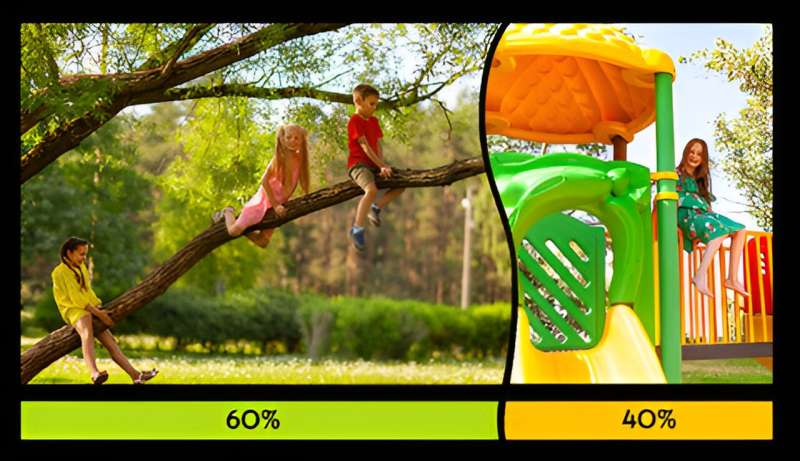This article has been reviewed according to Science X's editorial process and policies. Editors have highlighted the following attributes while ensuring the content's credibility:
fact-checked
trusted source
proofread
Plastic fantastic or nature-based playgrounds: Which is best for children's development?

Colorful slides and metal monkey bars are the mainstay of local playgrounds. But look around and you'll notice a growing trend for natural elements in children's play spaces, So, which is better for children's development?
Researchers at the University of South Australia have been exploring just this, finding that while both spaces have benefits, children prefer playing in places with nature play features such as trees, sand, and plants, rather than areas with typical play equipment such as slides and swings.
Observing 3- to 5-year-old children in early childhood centers, researchers found that children were significantly more imaginative and social in nature play areas, tending to play together more and be more creative. While in manufactured spaces, children were mostly involved in physical activities like climbing and playing on equipment.
Specifically, the study published in the International Journal of Early Childhood found that children spent most of their time (about 60%) in natural play zones, as compared to manufactured play areas (about 40%).
With early childhood (particularly years 0–5) known for being critical to a child's development, it's important that we understand how children achieve optimal cognitive, social, and physical skills.
In Australia, 1 in 5 children are developmentally vulnerable on one of five domains: language and cognition, communication, emotional maturity, social competence and physical health and well-being.
Lead researcher and Ph.D. candidate Kylie Dankiw says that embracing elements of nature in playground design could present greater opportunities for improved children's development.
"Nature play is globally recognized for the benefits it provides to young children, particularly in relation to developing cognitive and social skills, but also because it allows children to challenge themselves, take risks, explore and create," Dankiw says.
"So, it makes sense that there is a relationship between the features and components of an outdoor play space and the impacts on a child's development.
"In this study, we wanted to test this theory, by observing how and where children play and their different play behaviors.
"We found that most children tended to play more in nature zones, where they could explore and engage with nature, making mud pies, climbing trees, and exploring creek beds. Here, they tended to be more social, creative, and imaginative.
"Yet, children also liked playing on manufactured equipment where we watched them climb, swing or slide. And while they spend less time in these spaces, they did help the children build up physical and motor skills.
"What this shows is that nature play zones and manufactured play spaces both influence children's play in a positive way."
Co-researcher, UniSA's Dr. Margarita Tsiros, says the results of this study should interest landscape designers, teachers, parents, health professionals and child development experts to work together to make play spaces that help children grow and learn in different ways.
"Nature play spaces may be a sustainable and beneficial way to engage children with the natural environment," Dr. Tsiros says.
"When designing or upgrading a play space for young children, it's important to include a range of natural elements that are physically challenging (such as logs for balancing or climbing over), imaginative (such as loose parts to make mud pies), and that children can explore with their friends, (such as places to build cubbies and trade sticks).
"Traditional play equipment still has a role, but a mix of both may deliver engaging experiences and beneficial outcomes that promote children's development.
"If we can create play spaces that not only provide enjoyment but also contribute positively to children's learning, growth, and development then this is the ultimate goal."
"Nature play" is a widely used term developed to describe children's play that takes place in a natural environment and/or involves interaction with natural elements and features, such as water and mud, rocks, hills, forests, and natural loose parts, such as sticks, pinecones, leaves, and grass.
More information: Kylie A. Dankiw et al, Do Children Play Differently in Nature Play Compared to Manufactured Play Spaces? A Quantitative Descriptive Study, International Journal of Early Childhood (2023). DOI: 10.1007/s13158-023-00384-9
Provided by University of South Australia





















